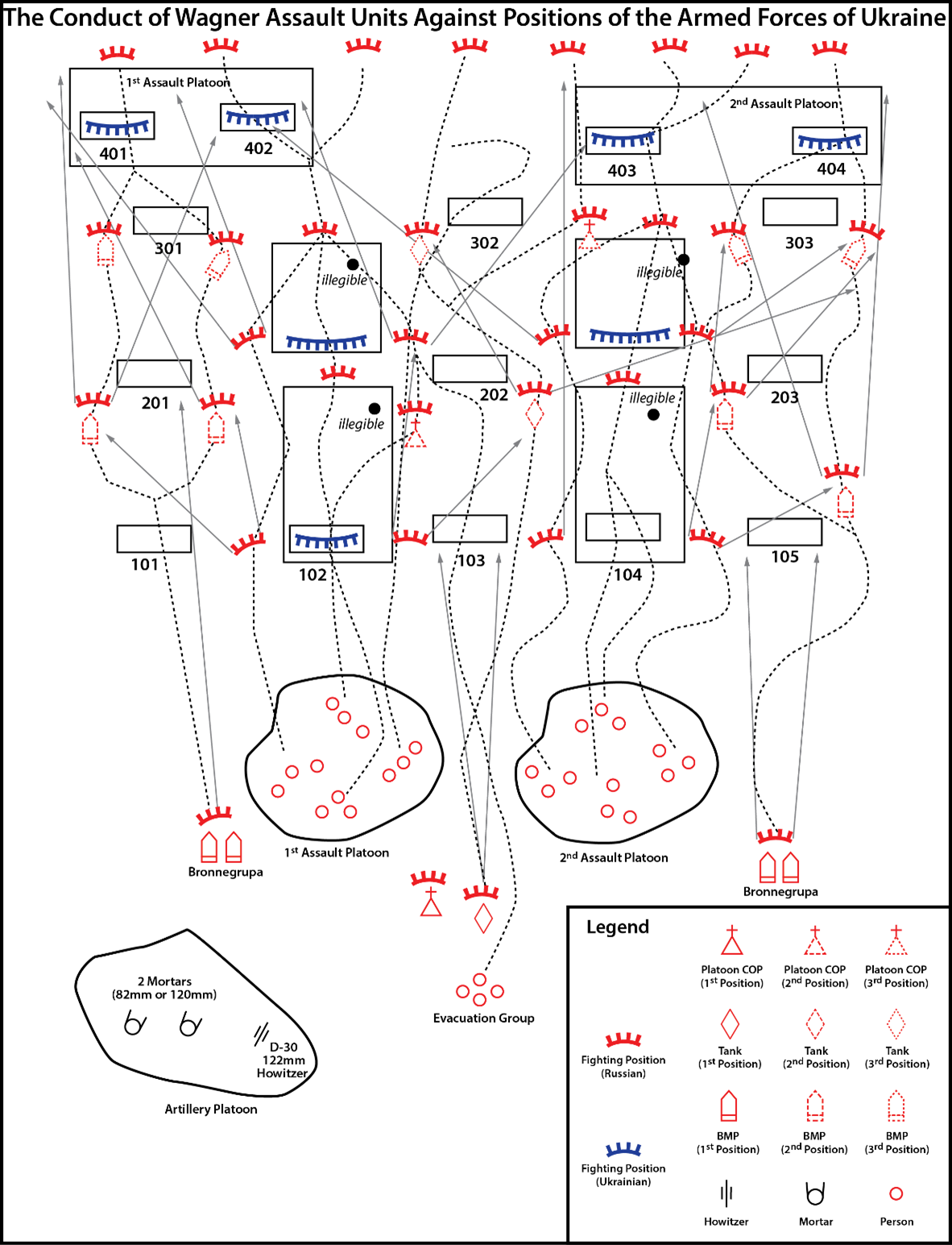
The Conduct of Wagner Assault Units Against Positions of the Armed Forces of Ukraine.
“The main task of the assault detachment for the day is to capture a platoon strongpoint.”
In February 2023, a pro-Russian Telegram channel called Institute of the SMO / People’s Translation, which translates Ukrainian-language documents into, posted a document purported to be a translation of a Ukrainian General Staff analysis regarding private military company Wagner assault detachments. The accompanying excerpts from the document describe the composition and tactics of Wagner detachments. The document also included the accompanying graphic depicting two dismounted Wagner assault platoons, supported by one tank and two bronnegruppa—infantry fighting vehicles, minus dismounts, providing supporting fires—attacking and penetrating a layered Ukrainian defense. There is an artillery platoon of two 82mm or 120mm mortars and one D-30 [GRLCUT(1] towed 122mm howitzer. The graphic depicts many planned artillery concentrations, annotated as three-digit numbers, and shows how fires will shift in relation to the advance of the Wagner assault platoons. The artillery platoon fires on the 100-level positions first, then and shifts fire to the 200 level, and then subsequent firing positions as the assault platoons advance. This scheme of fire suggests that the Wagner forces are expecting the Ukrainians to be well dug-in and dispersed. The relatively large number of artillery concentrations given such few artillery assets also suggests that there are additional artillery assets (not indicated on the graphic) that are supporting the attack, since the artillery platoon has insufficient assets and range (mortars) to fire the missions as depicted. There is likely an evacuation group that will advance behind the attack to repair or evacuate damaged vehicles. The adoption of these formations by Wagner illustrates how Russia is adapting trench warfare conditions more reminiscent of the First World War, as opposed to the high-speed maneuver warfare that was practiced during and after the Cold War. If these formations are deemed successful by Russia, it is likely the Russian Armed Forces will adopt similar ad-hoc structures for fighting in these conditions.
Source:
“Тактика ВСУ По Противодействию ЧВК «Вагнер» (Tactics of the Ukrainian Armed Forces against PMC ‘Wagner’),” Institute of the SMO / People’s Translation, a pro-Russian Telegram channel that translates Ukrainian language documents into Russian for the benefit of those fighting against Ukraine, 2 February 2023. https://tgstat.ru/channel/@svo_institute
This text is a direct translation from the Ukrainian language, compiled for scientific, educational, and reference purposes, has not been edited, should not be used for learning without understanding and interpretation, taking into account the circumstances of its origin. It does not reflect the position of translators and other participants in the “People’s Translation” project…
In the areas of concentration of the main efforts by the enemy, the units of the Defense Forces of Ukraine are increasingly faced with active opposition from the units of the Wagner PMC [private military company]. The enemy is trying to exert constant pressure on the chosen directions, so the attacks actually have the character of constant battle of small groups of light infantry. The first attack involves location of our fires assets for the enemy’s aerial reconnaissance platforms, and additional reconnaissance. As a result, the shelling of our positions after a repulsed attack is carried out in a way that is more massed than preparatory artillery strikes. And then a new attack is readied. This makes it possible to concentrate forces where Ukrainian troops have weaker reconnaissance, have fewer means of destruction, and have less resilience.
The enemy continues to apply new methods of warfare, testing them with the more trained units of the PMC “Wagner”, further spreading the experience gained in the infantry units. Based on the generalized data, it has been established that in order to carry out counteroffensive (assault) operations in the Liman direction, the enemy uses assault detachments (groups) (hereinafter referred to as assault units) and “fixing” units. If earlier assault detachments were mainly involved in conducting assault operations in the city, now the enemy uses assault units to carry out an offensive in all sectors of the line of contact and various types of terrain (urbanized terrain, forest, swamps, steppe zone, etc.).
Assault detachments are formed on the basis of a motorized rifle company, which is reinforced with tanks, flamethrower [thermobaric rocket launcher] and mortar crews, and ATGM crews. The team may also include:
• an engineer squad;
• a group from the GRU Spetsnaz brigade (reconnaissance unit);
• a UAV crew;
• an evacuation group.
The assault detachment is divided into 5-8 assault groups.
The assault group includes: a motorized rifle squad, reinforced with a grenade launcher and flamethrower crew.
The main task of the assault detachment for the day is to capture a platoon strongpoint. After completing the task, the detachment is withdrawn for 1-2 days to recover and rest. In place of the assault unit, “fixing” units are brought in. After reconstitution, the assault units can again be involved in combat.A “fixing” unit is a reinforced motorized rifle company or (motorized rifle platoon), from among the combined arms units (military units), as well as BARS [reserve] units and/or territorial troops…
Image Information:
Image: The Conduct of Wagner Assault Units Against Positions of the Armed Forces of Ukraine
Source: Foreign Military Studies Office, U.S. Army,
Attribution: Public Domain
